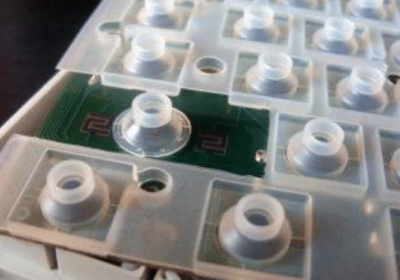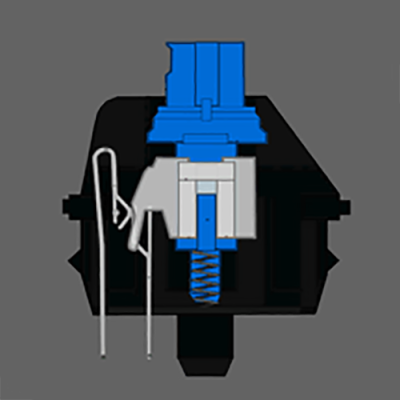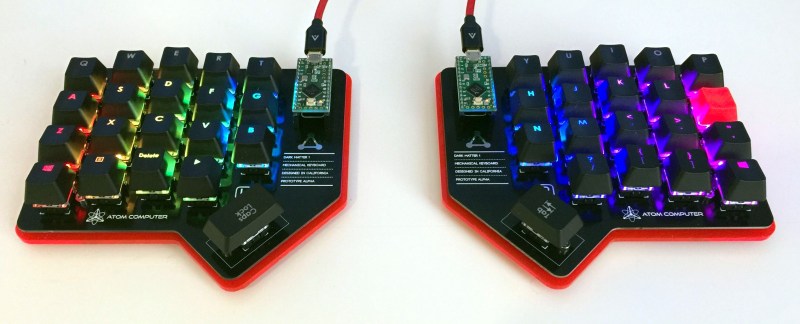There is an entire subculture of people fascinated by computer keyboards. While the majority of the population is content with whatever keyboard came with their computer or is supplied by their employer — usually the bottom basement squishy membrane keyboards — there are a small group of keyboard enthusiasts diving into custom keycaps, switch mods, diode matrices, and full-blown ground-up creations.
Ariane Nazemi is one of these mechanical keyboard enthusiasts. At the 2017 Hackaday Superconference, he quite literally lugged out a Compaq with its beautiful brominated keycaps, and brought out the IBM Model M buckling spring keyboard.
Inspired by these beautiful tools of wordcraft, [Ariane] set out to build his own mechanical keyboard and came up with something amazing. It’s the Dark Matter keyboard, a custom, split, ergonomic, staggered-columnar, RGB backlit mechanical keyboard, and at the 2017 Hackaday Superconference, he told everyone how and why he made it.

Ninety-nine percent of the keyboards you’ll ever see are crappy rubber dome keyboards. This is a specific type of switch, made with two contacts on a PCB, a sheet of rubber with a bunch of little bubbles in it, and a conductive foam pad mounted to the bottom of a key. The keys get their springiness from these rubber domes, and when a key is pressed it smashes into the PCB contacts, closing a circuit.
It’s certainly an inexpensive way to build a keyboard, but compared to a true mechanical switch it feels like crap. The key doesn’t activate until it hits bottom, and the lifetime of each of these switches is measured in the tens of thousands of cycles instead of the millions of cycles a mechanical keyswitch can handle.

On the other end of the spectrum is a mechanical keyswitch, best represented by the Cherry MX switch; a make and model of switch, with clones also built by Gateron and Kailh. These switches use actual springs and bits of brass to close a switch and they provide tactile feedback to the typist. There are even different varieties of MX-style switch; the ones with red stems are almost linear in their feedback, while browns, clears, and blues have a little bit of resistance in the middle of the key’s travel. The blues are clicky and are somehow even louder than the buckling springs found in the IBM Model M. They sound like a machine gun, and it’s awesome.
An entire community has grown up around putting these MX-style switches into custom designed enclosures for the perfect typing experience. There are innovations in ergonomics like columnar spacing, where the Q, A, and Z keys are in a straight line. There are split keyboards, where the left and right side of the keyboard are attached by a cable. Ariane decided he wanted the ultimate keyboard. It would be a split keyboard, and it should have a columnar layout. Because he’s part of the Hackaday crowd, this keyboard must have a ton of blinkies. This led to the creation of the Dark Matter keyboard, one of the most technologically impressive keyboards we’ve seen in a long time.
Like a lot of mechanical keyboard projects, Ariane is using a Teensy as the controller for each half of his keyboard. Unlike most mechanical keyboard projects, Ariane is using the Teensy LC, the cost-reduced version of this family of dev boards. Until very recently, the most popular firmwares for keyboards haven’t been brought over to the Teensy LC. Ariane did just that, and added support for driving WS2812 RGB LEDs. Combine this with an MX-compatible keyswitch with a clear housing and some polycarbonate keycaps, and Ariane made the blinkiest keyboard you’ve ever seen that doesn’t have individual OLED displays embedded in each keycap.
Ariane’s talk is a wealth of information on how to manufacture keyboards, from firmware and software development to how to build an enclosure. Keyboards are a surprisingly popular side topic in our little niche here on Hackaday, and we’re pleased Ariane could give this talk and extol the virtues of mechanical keyboards.

















This layout reminds me a lot of the Atreus keyboard. I built one earlier this year, and while I enjoyed the construction phase of the project, as well as my conversations with metalliqaz over on geekhack regarding his software easyAVR to use a graphical interface to set the layout (spoiler, the ‘Reset’ command cannot correct function with his code and the AStar board used on the Atreus) for me there simply aren’t enough physical keys. Doesn’t mean this is a bad build in any way, definitely impressive!
“They sound like a machine gun, and it’s awesome”
This reminds me of the South Park episode about Harley riders.
In the headline the phrase “staggered-columnar” appears, it’s columnar only. It’s funny how we have been handicapped for so long because four trackers side by side had to be arraigned in higher-lower order. Without offsets of course, lest the keys be heaver and wonkier. This was at a time when AGO became a standard for the 32 note double radiating pedalboard for organ, curved to fit our limbs. Because of a few hundred years history of clunkier pedalboards, European organs haven’t adopted AGO. Most organ stock is available in both straight and AGO versions on the world market, but in the US we have been ergonomic on this ‘board since professors at Purdue could remember when the school started.
Can’t watch the video right now, is this open source?
Yes. Most people use the TMK firmware which is what got the Teensy LC support recently. So the firmware is open and most PCBs that people make are open as well. Or hand solder the wires, PCB not required
“99% of keyboards” are membrane keyboards, not the rubberdome + pcb type that Brian pointed out. That’s pretty ancient keyboard technology
To be honest, membrane keyboards use those rubber domes as well. The 99% are of the rubberdome + membrane type. :)
I have this Osborne Executive laptop that uses this nasty foam in place of rubber domes. It has slowly degraded as time passes, so the keyboard on it feels like mush. It is by far the worst keyboard I have.
Very nice results, I didn’t know about the Teensy LC support until right now. Building a Dactyl keyboard has been on my todo list for a while.
Beautiful keyboard, but where’s the rest of it?
Many enthusiasts use the minimum amount of keys (you can find 30% and 40% layouts), and instead rely on layers activated by function keys in order to input other keystrokes. I prefer a compact full-size layout like the Cherry 1800 or 96% layout. That’s what’s great about the hobby though – if you don’t like a layout or want something slightly different, QMK firmware is there for you.
Exactly my thought. There is a reason we have 102 to 105 key keyboards and sometimes extra multimedia keys. Together these two keypads have about 40 keys, there is not even a space-bar. :-(
https://i.imgur.com/IfHrpB2.jpg
Proud of mine! The main keyboard is done, and only needs programming. The number pad still needs to be finished. The two halves magnetically snap together. It uses dyed Gateron MX Blues… I took each switch apart and dyed the housings blue. The entire board is hand wired, and the wiring is hand laced. The switch plate is custom cut and anodized. It’s based on a modified 75% layout, with an added column to the right of the Enter key. It allows for the ultra compact layout, without sacrificing a regular arrow configuration, or losing the page navigation keys. The number pad was made removable, so the main keyboard could slot into an opening in a custom kerbal space program controller I’ve been working on. The keycaps are SA row 3 profile “Danger Zone” caps. I spent more on those caps than any other part of the board, including the custom aluminum plate! O_o
Ugh… Dang it Imgur…
To view, open the image link in a new window, and reload if it still doesn’t load. I think they’re not working here.
That number pad looks like an aircraft instrument panel – fits the keycaps quite nicely.
Thanks!
The Danger Zone keycaps are aviation themed, and specifically were inspired by the movie Top Gun and the US Air Force, in general. Added to that are some Fallout themed artesian caps (they were made using the same grey and a very close blue) that work very well with this keyboard.
Underneath the keys, are amber LEDs. I went with amber to mimic the incandescent glow of instrument panel lighting.
The main keyboard is meant to slot into an instrument panel that will interface to the game Kerbal Space Program. The keyboard drawer can be slid out for normal use, including with the full number pad.
http://richfiles.solarbotics.net/eb/KerbalDesk3.png
i love my old model m keyboard, always searching for another in the flea markets
You left out the Cherry MX Black and for me those are the best ones. The keyboard I am typing this on uses them (Cherry G80-3000LAADE). Bought in 1996, in use ever since, never gave me problems. It still has an AT/XT switch and the big 5pin DIN plug.
I have the ever rare and elusive Chery MX Dark Blue. Only found on two models of keyboards. I still need to do somthing with them. I got them off of an old Bondwell B310+
Where are the very short throw keys for building custom keyboards? I’m talking Apple keyboard, ibm think pad, sorry if short throw and feel. I love typing on my Apple wireless keyboard but would also love to be able to setup macros layers and the like.
With time everything is getting advanced. I just wondered how do they do that. It takes a lot of hardship and time. For your hardship, we are getting the mechanical keyboards and thus experiencing better opportunity. Don’t stop this great work.